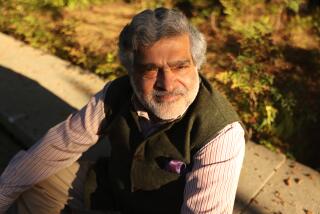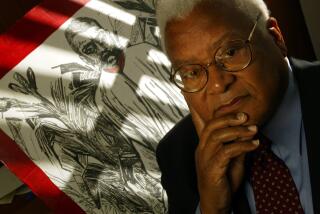Gerald Lawson dies at 70; engineer brought cartridge-based video game consoles to life
- Share via
Gerald A. “Jerry” Lawson, an electronics engineer and video game pioneer who led the team that developed the first cartridge-based home video game console system to hit the market in the mid-1970s, has died. He was 70.
Lawson, who lived in Santa Clara, died April 9 of complications of diabetes in El Camino Hospital in Mountain View, said his daughter, Karen Lawson.
One of a small number of African American engineers working in Silicon Valley, Lawson joined Fairchild Semiconductor in Mountain View in 1970 as an applications engineer working with the sales department.
Working in his garage on his own time in the early ‘70s, he created a coin-operated arcade game called Demolition Derby that incorporated a microprocessor.
At Fairchild, he became the chief engineer of the new video game division, which launched the Fairchild Channel F console in 1976.
Unlike other units whose games were preprogrammed by the manufacturer, the Fairchild Channel F enabled players to switch cartridges and play a variety of games such as Video Black Jack, Space War and Spitfire.
“The use of the cartridge was revolutionary in the game industry,” said Don Staub, the former components-marketing manager for Fairchild. “The cartridge allowed multiple games to be played on a single system.”
“Jerry was a visionary in this area of gaming,” said Staub. “In the conceptual aspects, he understood what the players wanted and could bring it to fruition.”
Greg Reyes Sr., a former group vice president of consumer products at Fairchild, said Lawson was “one of a kind.”
“He was brilliant, creative and innovative,” Reyes said.
In March, Lawson was honored by the International Game Developers Assn.’s Minority Special Interest Group at the Game Developers Conference in San Francisco.
“I found out about Jerry three weeks before our event,” said Joseph Saulter, chairman of the association’s Diversity Advisory Board.
“The minute I found out about him, I was so excited that I had to honor him in some way,” Saulter said. “I felt that his contribution to the industry was so immense, it brought tears to my eyes that he was never really recognized for his contribution to the industry.”
Lawson told the San Jose Mercury News in March: “The whole reason I did games was because people said, ‘You can’t do it.’ I’m one of the guys if you tell me I can’t do something, I’ll turn around and do it.”
Lawson was a big man who stood 6 feet 6.
“People liked Jerry,” said Staub. “He was imposing but gentle — and he knew a hell of a lot about electronics.”
David Erhart, an electrical engineer who knew Lawson, said he was “very straightforward, with no pretense.”
“He loved to teach,” said Erhart. “If there was a young person around, he loved to slow down and talk to them at the level they could understand and try to get them engaged in science and technology.”
The son of a science-loving longshoreman father and a mother who worked for the city of New York, Lawson was born in Brooklyn on Dec. 1, 1940, and grew up in Queens.
His mother saw to it that he received a good education.
“When she went to a school, she would interview the teachers, the principal, and if they didn’t pass her test, I didn’t go to that school,” he said in a 2009 interview with the website Vintage Computing and Gaming.
A photo of black scientist and inventor George Washington Carver on the wall next to his desk in the first grade — and a comment by his teacher — made a lasting impact on young Lawson.
“She said, ‘This could be you,’” he recalled in the 2009 interview. “Now, the point I’m getting at is, this kind of influence is what led me to feel, ‘I want to be a scientist. I want to be something.’”
While growing up, he made and sold walkie-talkies, built an amateur radio station in the housing project his family lived in and repaired TVs at different shops.
Lawson, who attended Queens College and the College of New York but did not receive a degree, later worked with the mentor program at Stanford University.
After leaving Fairchild in 1980, he launched Videosoft, a Santa Clara-based company that developed software for the Atari 2600 gaming system; he later worked as a consultant.
“I can’t say he ever officially retired because he was always working on a project for somebody,” said his son, Marc.
That despite losing vision in one eye and having a leg amputated below the knee due to his diabetes about eight years ago.
“He was one of those guys, his work was his hobby and his hobby was his work,” said Erhart.
In addition to his son and daughter, Lawson is survived by his wife of 45 years, Catherine; and his brother, Michael.
More to Read
Start your day right
Sign up for Essential California for the L.A. Times biggest news, features and recommendations in your inbox six days a week.
You may occasionally receive promotional content from the Los Angeles Times.




















































